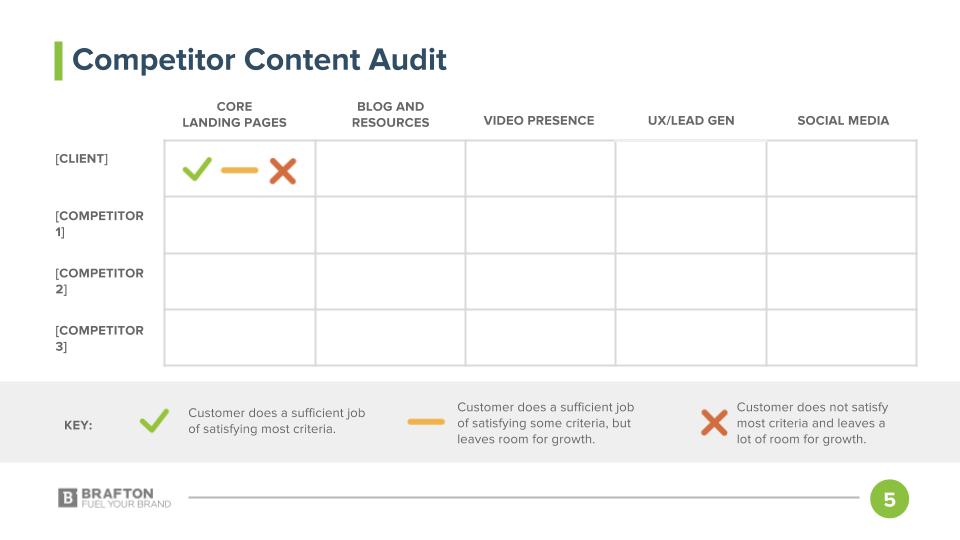It doesn’t take WikiLeaks to uncover your competitors’ secrets. With a few handy tips and a little digital surveillance, any marketer can become an agent for change in his or her company’s current content output.
A comprehensive digital marketing competitor audit does just the trick.

Let’s walk through the laser maze of your competition without tripping the alarm:
Classify your competition
It’s one thing to know who your competitors are in a general sense, but you need absolute clarity into who you will be auditing.
Break out your intelligence efforts into three categories: primary, secondary and tertiary competitors.
- Primary: Direct business competitors that overlap with your products, region and audience.
- Secondary: Semi-direct competitors that provide similar services as you but not always in a head-to-head fashion.
- Tertiary: Loosely related competitors that provide adjacent or ancillary services to yours but aren’t on your immediate radar and don’t impede your business goals.
It’s also recommended to limit the number of competitors you’re investigating for the sake of time and to avoid broadening the scope of your audit.
Conduct a site audit
With your eye keenly focused on the competitors that count, you need to pull back the mask on those companies’ websites.
Content is only as valuable as the platforms it’s displayed on, so a poor site is a definite sign of a competitor weakness. That said, a traditional website audit is most useful when you’ve integrated Google Search Console and Google Analytics with site-crawling tools. This obviously isn’t an option when dealing with access to competitors’ access credentials, but there are still practical and insightful ways to ways to analyze their sites.
Determine Domain Authority
Moz Open Site Explorer allows you to paste competitors’ URLs into its search field. It then reveals the Domain Authority scores of those sites. Compare this score to yours and you get a great sense of how you stack up and whether it may be worth it to compete head to head on certain search terms.
Inspect navigation, indexability, accessibility and UX
What are competitors’ pagespeed metrics? Google suggests 2.5 seconds or faster, but see for yourself using its PageSpeed Insights tool.
Are their sites utilizing structured data markup? A simple right click and “view page source” can give you quick visibility into this.
Additionally, view site navigation and general user experience. Is the navbar functional? Do pop-ups hide page content? Aggregating these site-level data and visual cues provides a clearer sketch of competitor competencies.
Document branding techniques
A less tangible but equally valuable way to identify potential strengths or weaknesses is by simply interacting with competitors’ sites and seeing what works visually and what can be improved upon. What messaging resonates?

Conduct a content audit
Beyond site-level audits, you need a thorough understanding of the exact types of content competitors are producing.
Subscribe to their newsletters
Get insights delivered straight to your inbox. How are emails phrased? How are newsletters formatted? Are there CTAs?
Review three months of blog posts
Look back at recent blogs to gather current content direction, themes and opportunities. Are they targeting specific verticals? Are there gaps in their research or reach?
Assess visual capabilities
Search engines crave media-rich content, yet many brands are still creating blogs, landing pages and marketing collateral with a 2010 mindset. Outdoing competitors on images, videos, gifs, graphics and interactive features is a quick way to create content that is likelier to rank organically.
Analyze production capacity
Are competitors clearly leveraging an agency to churn out a monster amount of quality content? Are their blogs updated infrequently? Are they focused on specific content formats over others?
Know what others are prioritizing and how fast they can get those assets out the door to help shape your production timelines.
Conduct a social media audit
On top of email marketing, social media is a growing distribution channel that will only become more important over time. A competitive social media analysis shines a light on the promotion and amplification side of content.
Check posting frequency and platform usage
Depending on your market, certain social platforms are more advantageous. One of the top B2B marketing trends in 2018 will be companies moving their social spend toward fewer, higher-value platforms. See how often competitors post, the tone and media they use and what appears to be generating traction.
Understand their social engagement metrics
Strong social signals are increasingly more important to overall web presence, and they lend additional authority and ranking potential to companies with powerful social media metrics.
Followers are of less importance, but comments, subscriptions, reviews, shares and likes are the indicators to be mindful of.
Create a strength/weakness matrix
Armed with a trifecta of site, content and social media audits, format all of your findings in a presentable way. A simple matrix that lists your competitors and their respective strengths and weaknesses in the categories that matter most to you works well, and you can quickly share this doc with other stakeholders and grasp where your own shortcomings lie.
Here’s an example:

Draft a priority scorecard
At the end of your competitive probe, you need action items.
Rank, organize and align tasks that are short-term, near-term and long-term priorities. This blueprint empowers you to track progress, make adjustments and stay the course.
By assigning a value to the tasks your organization needs to focus on, you can efficiently present your digital strategy, expectation and goals to your boss in a way that’s boiled down to simple numbers.
Attack, attack, attack
You’ve come all this way to win.
A competitive digital marketing audit lays the groundwork, but now you have to translate research into ROI.
Target low-hanging SEO opportunities, create a stronger voice on social, fix your site errors, ensure a flawless user experience across all browsers and device types, create content for audiences competitors aren’t targeting and focus on high-value, commercial-intent prospects.
Easy enough?





